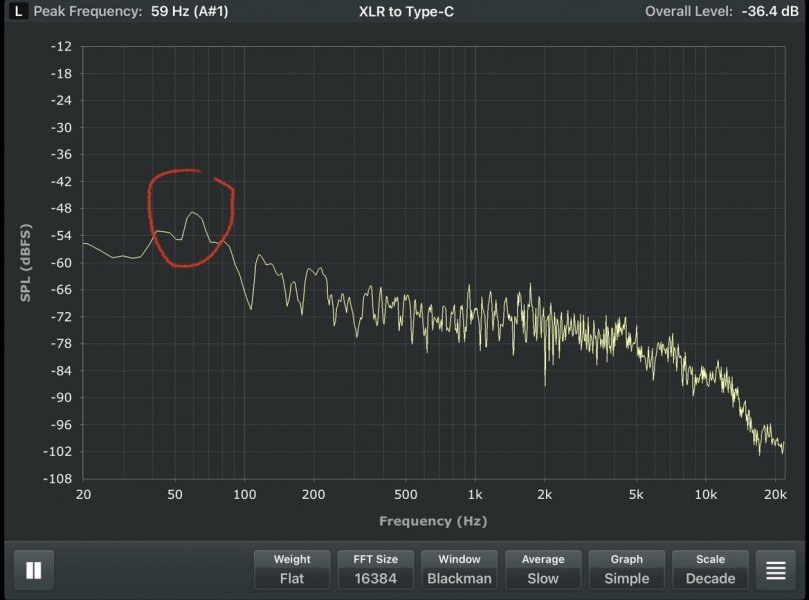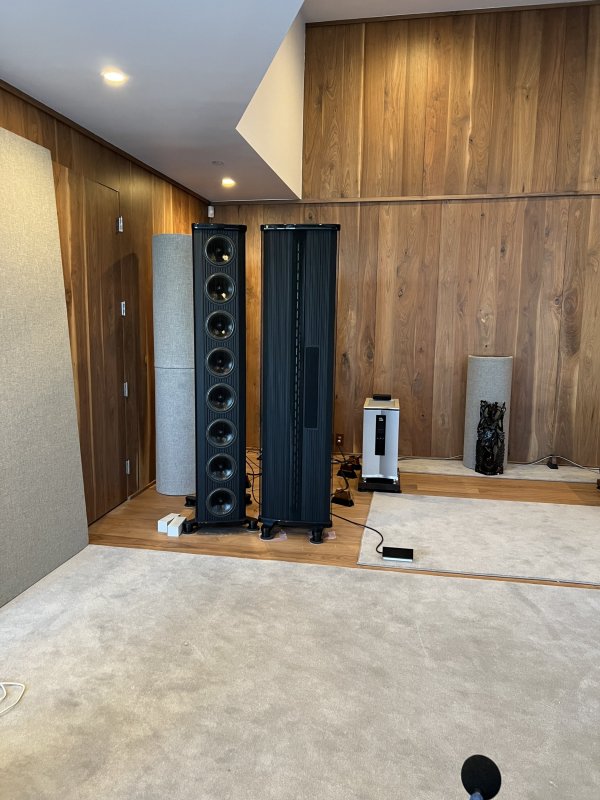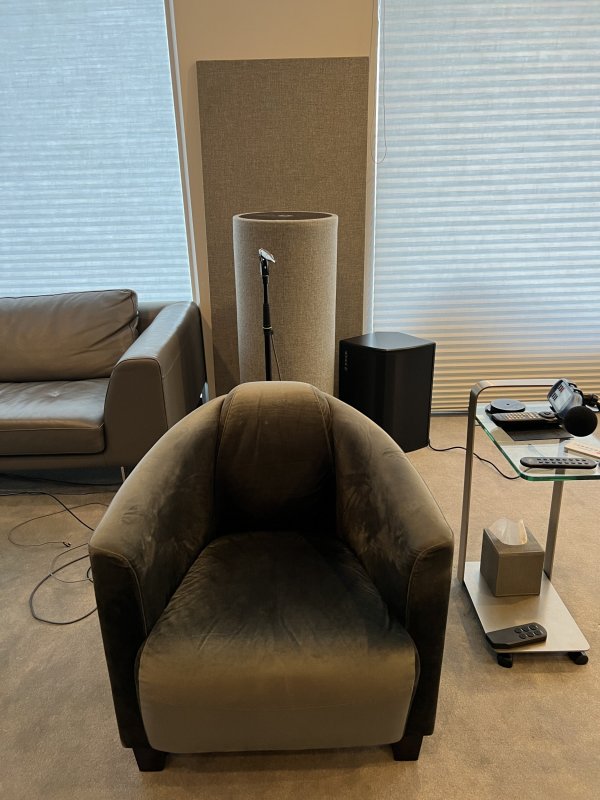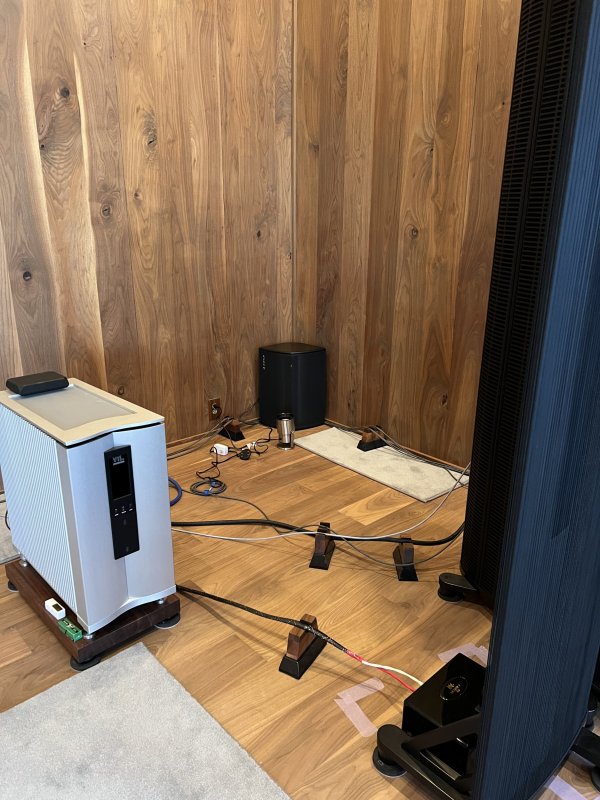There is a Vitavox S2 compression driver in between the bass and the tweeter.Do you happen to know the approximate xover point of the main woofer bin (not the subwoofer) to the TAD 2002 in the VOX OLYMPIAN?
Ron’s New System
- Thread starter Ron Resnick
- Start date
You are using an out of date browser. It may not display this or other websites correctly.
You should upgrade or use an alternative browser.
You should upgrade or use an alternative browser.
Do you happen to know the approximate xover point of the main woofer bin (not the subwoofer) to the TAD 2002 in the VOX OLYMPIAN?
It is listed as 450Hz on the Living Voice website:
https://www.livingvoice.co.uk/technical-specifications-vox.html
I have heard Perahia play 3, 4, 5 live across a couple of concerts.
How do you recommend getting good quality recordings of his playback on analog?
Ron can get a tape machine and record the existing digital versions ....
I did not recommend recordings - just informed on my preference. Curiously the CBS versions of the 80's have excellent sound quality, with adequate balance between soloist, instrument sections and orchestra.
You say Peter believes neither his Vitavox nor David's Bionar system roll off treble frequencies. You say Peter believes that some modern systems emphasize treble frequencies. You imply that one of those beliefs needs to be false for the other to be true. Really ? I see no contradiction in holding both beliefs. Why do you believe they need to be reconciled?
So your reference becomes a measurement?
What do you hear in the concert hall?
The notion that there is an objective frequency response against which listening is assessed and gauged correct or not is a dire turn of direction that ultimately leads to grading/gauging peoples hearing. Is that where you want to go?
Considering the average age of WBF active members surely measurements carried in well explained conditions are needed to substantiate such claims. And we would need at less spatial averaged measurements, not just the single on axis measurement.
Thanks, I had the wrong driver name in mind, I indeed meant the large Mid Range horn.....There is a Vitavox S2 compression driver in between the bass and the tweeter.
Ron, why do you attribute this sense of realism to the Bionors? You were listening to a whole system. I have spoken to David at length about what is responsible for what. He attributes much of what you describe to his superior power delivery, the Neumann cartridge, and his AS2000 design. When I changed my power, from grounding to in wall wires to outlets and power cords, I heard a massive improvement in the weight, impact and fullness of the upper bass to lower midrange presentation.
I attribute the sense of realism to the speakers because in my experience they are the biggest factor in the equation of David's system. I heard the impact of the Neumann cartridge by itself in direct comparison with the vdH by itself. Yes, the Neumann cartridge does something special, but I do not quantify it as a "massive" difference.
I have heard Lamm in many systems. I understand how Lamm sounds and how it behaves in systems. I don't happen to agree that in SET land there is Lamm and then there is everything else. I think Absolare SET is in the same league.
I don't think the AS-2000 is powering particularly the upper bass/lower midrange region. I think the AS-2000 is bringing its unique weight to bear probably most uniquely in the lowest frequencies (but this is speculation) and in unmatched resolving power. I think the TechDAS AF3P probably is fuller and warmer in the upper bass/lower midrange region than is the AS-2000.
Also, I heard at David's the exact same front-end and electronics applied to different speakers, and the sonic center of gravity was significantly different.
I can't dispute what you say you heard and I cannot dispute your quantification. I can say that it sounds hyperbolic and that it does not make sense to me that switching from JPS in-wall cable to regular copper and switching from fancy power cords to Ching Chengs results in a "massive improvement in the weight, impact and fullness of the upper bass to lower midrange presentation." It's entirely possible that we apply a significantly different quantification to the word "massive."
Here is an example of where I would use the word "massive." I would characterize switching from Martin-Logan CLS to Bionor as a "massive improvement in the weight, impact and fullness of the upper bass to lower midrange presentation." I just can't imagine your power and cable swap as occasioning the same difference in subjective presentation as between these two loudspeakers.
So based on my experience at David's and elsewhere I am very comfortable attributing most of what I am describing to the Bionors.
Last edited:
Ron, why do you attribute this sense of realism to the Bionors? You were listening to a whole system. I have spoken to David at length about what is responsible for what. He attributes much of what you describe to his superior power delivery, the Neumann cartridge, and his AS2000 design. When I changed my power, from grounding to in wall wires to outlets and power cords, I heard a massive improvement in the weight, impact and fullness of the upper bass to lower midrange presentation.
I think you should ask David to replace his Bionors with AG Duos or Unos then check.
Having listened to four different speakers when I was there, I attribute what I heard at David's to the entire system, not just the Bionors. More than the ML3 amps, there is the Lamm LL1.1 linestage and the LP1 phonostage. The AS2000 w/ SME3012 is a key critical component. It is not by accident or in virtue of a single component that the sound - a natural sound in each instance - results from the integration of components selected to create it.
I can't dispute what you say you heard and I cannot dispute your quantification. I can say that it sounds hyperbolic and that it does not make sense to me that switching from JPS in-wall cable to regular copper and switching from fancy power cords to Ching Chengs results in a "massive improvement in the weight, impact and fullness of the upper bass to lower midrange presentation." It's entirely possible that we apply a significantly different quantification to the word "massive."
Ron, I didn’t say it was just the in wall cable and power cords when describing the improvement I heard with my power delivery. I wrote it was everything from the grounding rod to the power cord. There is an entire new dedicated panel separate from the rest of the house with a very specific grounding cable and rod installation. I also mentioned outlets. I am talking about everything from the meter to the component. You may dismiss this stuff because you have not done the experiments. I’ve done a careful analysis of David’s power delivery at his house. He explained to me what he did. Mine is very similar and I heard the before and after contribution to the sound. It is significant to the clarity and energy level and definition of the bass to lower mid range frequency area Have you heard the Bionor‘s without the subwoofers?
I have also done careful direct comparisons between the Micro Seiki, the AS1000 in the AS2000 in my own system. I was very deliberate in my explanation of what I attribute the sound too. It is based on extensive listening and experimentation. You can dismiss it and attribute it to what you want, but we disagree.
To simply conclude that it is a result of the speakers in my opinion is an incorrect and incomplete analysis.
Last edited:
Have you heard the Bionor‘s without the subwoofers?
This is a fair point I should correct. All of my comments about the Bionors include the JBL subwoofers as part of the "loudspeaker."
Jason Hanan, President of Pro Audio LA, and his colleague, Richard, visited me today to give me a demo of PSI AVAA active bass frequency absorbers.
Coming as they do from the pro audio world, as opposed to the audiophile world, I expected the AVAAs to do something unambiguously. And they did!
I was expecting Jason to plop an AVAA in each front corner, and he did, indeed, start there. But he is a very experienced professional at walking slowly and carefully around the room with certain frequencies playing, and feeling the pressure nodes of the room at different frequencies.
Jason determined that the front right side of the room has a node at about 50 Hz, while the front left side of the room has a node at about 60 Hz. He thinks this is due to the asymmetric ceiling height caused by the 9' ceiling soffit on the left side of the room (versus the 14.5 foot ceiling height for the rest of the room).
Impressively, Jason experimented not only with different locations and different frequencies for the AVAAs, he integrated a lot of experimentation with my inventory of ASC TubeTraps as well. He likes having both of these acoustic tools at his disposal to identify and mitigate room nodes.
Jason spent a lot of time having his colleague, Richard, slowly rotate the TubeTraps' absorption side versus diffusion side orientation to maximize the mitigation of sound pressure areas.
Jason believes that my 60Hz (and 50Hz) problems are primarily a function of room dimensions, and not a function of woofer tower positioning.
BEFORE

AFTER

We listened to two songs and I could hear a significant improvement. On those two songs there was no longer any obvious room boom.
I haven't had a chance yet to listen more extensively (we spent most of the day with Lola at the emergency room as she fell ill on Wednesday night (kids! ), but I hope to be able to do some listening this weekend.
), but I hope to be able to do some listening this weekend.
One AVAA wound up in the front right corner, and the other AVAA wound up just behind the listening position. I may order a third AVAA for the front left corner.
I am going to have put tape around the TubeTrap positions, as well as preserve the absorption/diffusion directional orientations. I am afraid to move or tinker with anything, lest I lose the results we have achieved thus far. The TubeTraps look to be a little bit randomly scattered around the room now, but they are positioned carefully to absorb the pressure nodes.
Jason advised that one should not substitute objective measurements for subjective listening impressions. He said he has had experiences where an improved frequency response chart actually resulted in a less attractive subjective sonic result. I am not moving a thing now. I have to spend a lot of time listening to the new acoustic arrangement
i bought on the spot the two AVAAs Jason and Richard brought today. I especially appreciate the way Jason used the TubeTraps with the AVAAs to achieve a better result than either product could achieve alone.
I highly recommend AVAAs! They actually work! I especially recommend that you hire Jason personally to install them for you!
Thank you, Jason! Great job!
Jason Hanan
President
Pro Audio LA
323-319-5936
jason@proaudiola.com
https://www.proaudiola.com/
Coming as they do from the pro audio world, as opposed to the audiophile world, I expected the AVAAs to do something unambiguously. And they did!
I was expecting Jason to plop an AVAA in each front corner, and he did, indeed, start there. But he is a very experienced professional at walking slowly and carefully around the room with certain frequencies playing, and feeling the pressure nodes of the room at different frequencies.
Jason determined that the front right side of the room has a node at about 50 Hz, while the front left side of the room has a node at about 60 Hz. He thinks this is due to the asymmetric ceiling height caused by the 9' ceiling soffit on the left side of the room (versus the 14.5 foot ceiling height for the rest of the room).
Impressively, Jason experimented not only with different locations and different frequencies for the AVAAs, he integrated a lot of experimentation with my inventory of ASC TubeTraps as well. He likes having both of these acoustic tools at his disposal to identify and mitigate room nodes.
Jason spent a lot of time having his colleague, Richard, slowly rotate the TubeTraps' absorption side versus diffusion side orientation to maximize the mitigation of sound pressure areas.
Jason believes that my 60Hz (and 50Hz) problems are primarily a function of room dimensions, and not a function of woofer tower positioning.
BEFORE

AFTER

We listened to two songs and I could hear a significant improvement. On those two songs there was no longer any obvious room boom.
I haven't had a chance yet to listen more extensively (we spent most of the day with Lola at the emergency room as she fell ill on Wednesday night (kids!
One AVAA wound up in the front right corner, and the other AVAA wound up just behind the listening position. I may order a third AVAA for the front left corner.
I am going to have put tape around the TubeTrap positions, as well as preserve the absorption/diffusion directional orientations. I am afraid to move or tinker with anything, lest I lose the results we have achieved thus far. The TubeTraps look to be a little bit randomly scattered around the room now, but they are positioned carefully to absorb the pressure nodes.
Jason advised that one should not substitute objective measurements for subjective listening impressions. He said he has had experiences where an improved frequency response chart actually resulted in a less attractive subjective sonic result. I am not moving a thing now. I have to spend a lot of time listening to the new acoustic arrangement
i bought on the spot the two AVAAs Jason and Richard brought today. I especially appreciate the way Jason used the TubeTraps with the AVAAs to achieve a better result than either product could achieve alone.
I highly recommend AVAAs! They actually work! I especially recommend that you hire Jason personally to install them for you!
Thank you, Jason! Great job!
Jason Hanan
President
Pro Audio LA
323-319-5936
jason@proaudiola.com
https://www.proaudiola.com/
Last edited:
I will be substituting for my four standard 16" round TubeTraps four custom 20" round TT-HH (Helmholtz) TubeTraps. The first two that I ordered a couple of weeks ago will be tuned to target 60Hz. Thanks to Jason's analysis today, the additional pair I order will be tuned to target 45Hz or 50Hz.
I should remind y'all that with the woofer level control I can bring down the entire 20 Hz to 100 Hz range to make it more level with the adjacent 100Hz to 300Hz section of the frequency response curve. But as long as I don't hear the bass bump, and as long as there is no blurring of low frequency detail or texture, I am happy with a little extra measured oomph below 100Hz. I'll be curious to learn if I actually hear that extra oomph at the current woofer level setting now that the bass nodes are being addressed.
I will play with the woofer level control as time goes on.
I will play with the woofer level control as time goes on.
RonI should remind y'all that with the woofer level control I can bring down the entire 20 Hz to 100 Hz range to make it more level with the adjacent 100Hz to 300Hz section of the frequency response curve. But as long as I don't hear the bass bump, and as long as there is no blurring of low frequency detail or texture, I am happy with a little extra measured oomph below 100Hz. I'll be curious to learn if I actually hear that extra oomph at the current woofer level setting now that the bass nodes are being addressed.
I will play with the woofer level control as time goes on.
Did Jason use a measuring device .. I woud be interested to see how it correlated with Ipad.
It looks like you have smoothed it out right through the range .. thats great !
Does it sound sightly less reverbarent now ?
Cheers
Phi
Yeah, nothing wrong with a little "junk in the trunk." It is ok as long as you know what's going on.I should remind y'all that with the woofer level control I can bring down the entire 20 Hz to 100 Hz range to make it more level with the adjacent 100Hz to 300Hz section of the frequency response curve. But as long as I don't hear the bass bump, and as long as there is no blurring of low frequency detail or texture, I am happy with a little extra measured oomph below 100Hz. I'll be curious to learn if I actually hear that extra oomph at the current woofer level setting now that the bass nodes are being addressed.
I will play with the woofer level control as time goes on.
Ron
Did Jason use a measuring device .. I woud be interested to see how it correlated with Ipad.
It looks like you have smoothed it out right through the range .. thats great !
Does it sound sightly less reverbarent now ?
Cheers
Phi
Hi Phi!
I don't think reverberation time was a problem. Jason found the room overall subjectively to be on the "slightly live" side, but that's exactly where I wanted to end up.
A certain electric keyboard key in Sarah McLachlan's "Witness" lit up the room boom like a Maglite. I have to check to see how that song that sounds now.
| Steve Williams Site Founder | Site Owner | Administrator | Ron Resnick Site Owner | Administrator | Julian (The Fixer) Website Build | Marketing Managersing |





